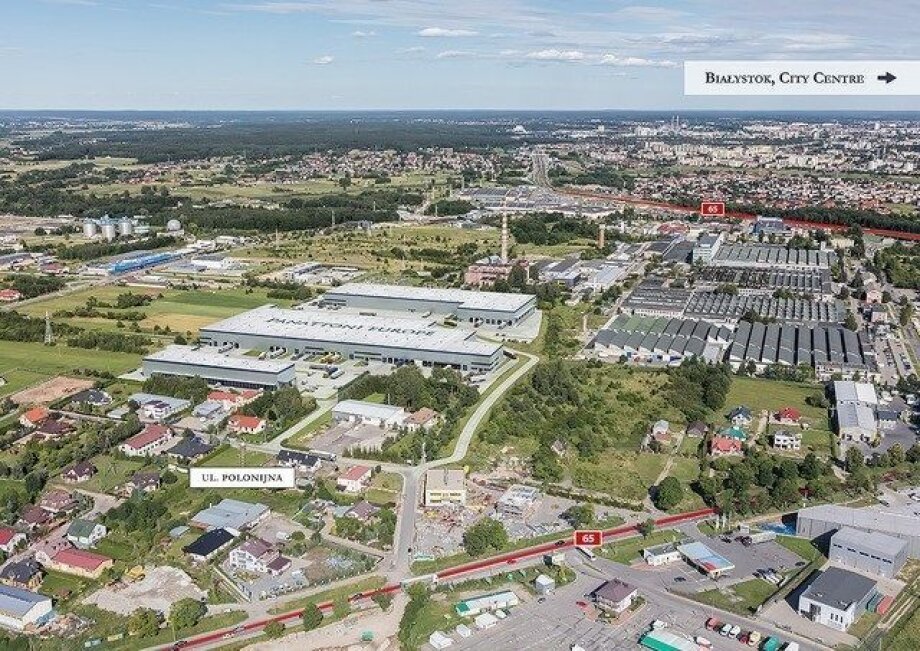Developer Panattoni Europe has recently finished construction work on Panattoni Park Białystok, the company’s first project in the capital of the Podlaskie voivodship and the first class-A logistics park scheme in north-eastern Poland. The development – which is located within the administrative boundaries of the city, approximately one kilometer from the S8 expressway – comprises a total of more than 41,000 sqm in three buildings. Its tenants include logistics operator Rohlig Suus Logistics.
Panattoni Europe – which has been investing in so-called emerging logistics property markets across Poland and earlier also entered two other major eastern Polish cities, Lublin and Rzeszów – believes in the potential of Białystok and the eastern Poland region in general. The developer argues that the growth of the e-commerce market and the development of transport infrastructure mean that such cities are a natural choice for the logistics sector and thus also for logistics space providers.
NASCENT MARKET
When set against some of the more established locations in Poland, the size of the logistics property market in the east of the country does not look impressive. Cushman & Wakefield says that the existing stock there reached 570,000 sqm in the third quarter of last year. This accounts for less than 4 percent of the aggregate logistics space volume in the country. In Q1-Q3 2018, some 100,000 sqm was delivered in the region (Cushman & Wakefield also counts Kielce as an eastern location), compared to about 106,000 sqm in the whole of 2017.
Meanwhile, at the end of Q3 2018, the total existing stocks in central Poland, Silesia and the Warsaw area amounted to almost 1.95 million sqm, over 2.7 million sqm and more than 3.85 million sqm respectively. In central Poland, 210,000 sqm was delivered in that quarter alone. At the end of September, as much as 584,000 sqm was under construction there, while the figures for Silesia and the Warsaw area stood at 383,000 sqm and 259,000 sqm respectively. By comparison, the figure in eastern Poland was over 35,000 sqm.
Admittedly, the market is still very young – the first modern logistics parks sprang up in eastern Poland only three or four years ago. The completion of Panattoni Europe’s Białystok development basically means the creation of a completely new logistics location. Some of the major warehouse space developers remain more cautious when it comes to launching new projects in the region. MLP Group, which is already present there, wants to focus on the leading markets in Poland, as well as on the German market, in the near future.
The company has been developing a 45,000-sqm logistics park in Lublin since 2014, with its final phase scheduled to be completed in Q2 2019. “The entire complex is currently fully leased out and houses three tenants,” said MLP Group’s sales director Agnieszka Góźdź. “This confirms that such schemes are needed and sought after,” she added. The developer is planning another logistics park project near Lublin. Nevertheless, the company sees much more tenant interest and better growth prospects in bigger markets, Góźdź said..
The investment strategy of Prologis, too, envisions growth in the biggest logistics locations in Poland in the near future. The company is now focusing on expansion in four key regions: the Warsaw area, Łódź, Wrocław and Poznań. Next year, the developer will open seven buildings comprising a total of more than 200,000 sqm located within four logistics parks there, said Paweł Sapek, senior vice president and country manager for Poland at Prologis.
“At the moment, we are not building any speculative projects in the eastern part of the country, but we are constantly watching the market and monitoring the needs of our clients,” Sapek said. The developer could deliver built-to-suit schemes in the region if need be. In Sapek’s opinion, investments in eastern Poland are predominantly of a local nature and are launched as a result of the organic growth of the companies present there. They often only operate in the domestic market or have business relations with Poland’s eastern neighbors.

POSITIVE PROSPECTS
Indeed, logistics property experts admit that most of the companies that take up warehouse space in Poland still prefer locations close to the biggest cities across the country, which also happen to be the most absorptive markets. As for smaller, less-established locations, tenants and developers often choose those in western and northern Poland as they ensure easy distribution of goods to Western Europe, especially to Germany. This matters when one looks at the nature of Poland’s foreign trade.
Germany remains Poland’s most important trade partner. In 2017, the country accounted for 27.4 percent of Poland’s exports and 23.1 percent of Poland’s imports, noted Adrian Semaan, consultant in the industrial and logistics agency of Cushman & Wakefield. Other growth barriers in eastern Poland include the lack of major producers who would generate the need for an entire chain of suppliers and distributors around them, maintained Wojciech Waryś, partner, industrial and logistics, at Axi Immo.
The logistics property map of Poland is not likely to be redrawn in any significant way in the foreseeable future. However, this does not mean that the east of the country will not grow in importance. In fact, new road infrastructure has already made it more attractive. The S8 expressway connecting Warsaw and Białystok has recently been completed. Stretches of road which will be part of the Via Baltica and Via Carpatia trans-European transport corridors are under construction or in the pipeline.
The former will connect Warsaw with Tallinn in Estonia, while the latter will run from Klaipeda in Lithuania to Thessaloniki in Greece, with its Polish stretch set to link the three biggest cities in eastern Poland – Białystok, Lublin and Rzeszów. Both routes will be important for the further development of trans-border logistics in the eastern part of the European Union and, consequently, of the logistics property market in Poland’s eastern locations. There are already some signs of that positive impact.
While take-up has remained at roughly the same level in recent years – approximately 85,000 sqm of warehouse space was leased in eastern Poland in Q1-Q3 2018, compared to an average of around 87,000 sqm in the same period of 2014-2017 – its structure has been changing. Apart from companies investing in production processes, logistics operators have also been increasingly active when it comes to leasing space in the region. This is a positive signal as far as the expected growth of the market in the coming years is concerned, Semaan claimed.
Apart from improving transport infrastructure, relatively easy access to employees and lower labor costs are also an increasingly important asset of the eastern Polish logistics locations which are attracting companies that plan major recruitment processes. Waryś pointed out that the average unemployment rate in eastern voivodships stands at 7.9 percent (in some locations it is 10-12 percent), while in Wrocław and Poznań the figure is 3 percent and 2 percent respectively. “This is a big difference for companies needing to hire many people,” he said.



















